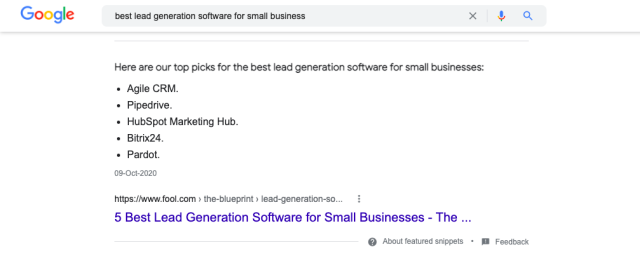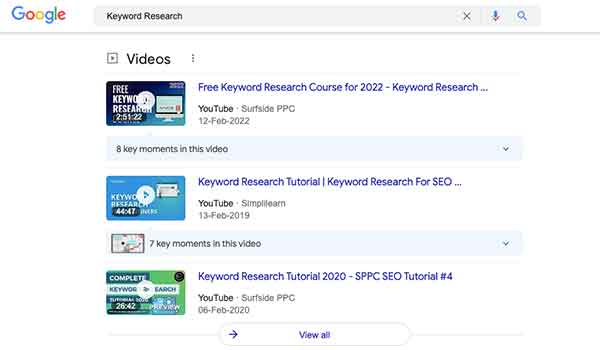If you’re looking to improve your website’s search engine ranking, you need to start with keyword research. This process involves finding the right keywords that people are using to find information online. If you can find keywords with a high search volume but low competition, you’ll be able to rank high in the search engines. Here, we will discuss finding the right keywords for your business and how to rank them on Google!
Introduction to Keyword Research
Before we get into finding the right keywords for your business, let’s take a step back and understand more about keyword research. Keyword research is finding and analyzing search terms that people enter into search engines, intending to use that data for a specific purpose. The most common purpose of keyword research is search engine optimization (SEO).
When you do keyword research, you’re looking for words and phrases people use when searching for information online. You can then use these keywords in your website content, titles, and tags to help improve your website’s ranking in the search engines. In addition to SEO, keyword research can also be used for general marketing purposes. For example, you might use keyword data to understand what topics are popular among your target audience.
Keyword: A keyword is a term used in digital marketing to describe a word or a group of words an internet user uses to perform a search in a search engine or search bar.
In an SEO strategy, keywords are essential and should be the core of any copy written for the web (present in the content, titles, and SEO elements).
Keywords should be developed and carefully selected before launching content on the web and mobile platforms.
Importance of Keyword Research
Why is keyword research important? Because it allows you to understand what people are searching for online. This data can then form your content strategy and marketing efforts.
If you want to rank high in the search engines, you need to target keywords with a high search volume but low competition. In other words, you want to find keywords that many people are searching for but not many websites are targeting. This can be a challenge, but it’s worth it because ranking high in the search engines can increase your website’s traffic and visibility.
Here’s how keyword research can help:
Understanding Marketing Trends:
By analyzing the keywords that people use to find information online, you can get insights into current marketing trends. This data can help you adjust your marketing strategy to align with what your target audience is interested in.
Improving Website Content:
If you’re not using the right keywords in your website content, you’re missing out on an opportunity to rank high in the search engines. Keyword research can help you find the right keywords to use in your content to improve your website’s ranking and get more traffic.
Centering Your Content on Relevant Topics:
If you want your content to be relevant and valuable to your target audience, you need to make sure it’s centered on the right topics. Keyword research can help you understand what topics are most popular among your target audience so that you can create content that meets their needs.
Identifying New Business Opportunities:
By understanding what people are searching for online, you might be able to identify new business opportunities. For example, if you see many people searching for a particular product or service, but there aren’t many businesses offering it, then that could be an opportunity for you to fill the gap in the market.
Now that you know the importance of keyword research, let’s look at the different elements of keyword research.
Elements to Consider When Doing
Keyword Research
When conducting keyword research, there are three main elements to pay attention to relevance, authority, and search volume.
Relevance:
As we mentioned before, Google ranks content for relevance. Your content will only rank for a keyword if it meets the searchers’ needs. In addition, your content must be the best resource out there for the query. After all, why would Google rank your content higher if it provides less value than other content on the web?
Authority:
Google will provide more weight to sources it deems authoritative. That means you must do all you can to become an authoritative source of information for your target keywords. Some ways to build authority include creating high-quality content, getting links from other websites, and being active on social media.
Search Volume:
The search volume is the number of times a keyword is searched for in a given time. The higher the search volume, the more potential traffic for that keyword. However, you also need to pay attention to the competition for a keyword. If many websites compete for the same keyword, it will not be easy to rank high in the search engines.
Creating Keyword Research Strategy for Your SEO Campaigns
Now that you understand the elements of keyword research, it’s time to start creating a keyword research strategy for your SEO campaigns. Here are four steps to help you get started:
Come up with a list of potential keywords
The first step is to come up with a list of potential topics or buckets that are important to your business.
If you’re unsure where to start, think about the topics you blog about most frequently or the ones that come up the most in sales conversations. You can also ask your customers what they would search for if they were looking for a business like yours.
For example, if you sell marketing software, some potential topics could be:
- Lead generation
- Content marketing
- Social media marketing
- Email marketing
Find relevant keywords for each topic bucket
Once you have your list of potential topics, it’s time to find relevant keywords. There are several different keyword research tools you can use to do this. The best SEO keyword research tools are Google Keyword Planner, Moz Keyword Explorer, and SEMrush Keyword Magic Tool.
When you’re using a keyword research tool, there are a few things to keep in mind:
- Make sure the keywords are relevant to your business and target audience.
- Look for keywords with high search volume and low competition.
- Find a mix of short-tail and long-tail keywords.
Analyze how these keywords relate to user intent
Once you have a list of relevant keywords, it’s time to analyze how they relate to user intent. Remember, the goal is to create content that meets the searchers’ needs. That means you need to understand what people are looking for when searching for each keyword.
There are four main types of user intent:
- Navigational: The person is looking for a specific website or page.
- Informational: The person is looking for information on a topic.
- Transactional: The person is looking to buy something.
- Commercial Investigation: The person is shopping or researching a purchase.
Find related search terms for each keyword
The last step is to find related search terms for each keyword. This can be done by looking at Google’s related searches or using SEMrush’s Keyword Magic Tool.
This is a great way to find long-tail keywords you may not have thought of before.
Long-Tail Keywords: These are more specific keywords – and usually longer – than more commonly used keywords. Long-tail keywords get less search traffic but will usually have a higher conversion value as they are more specific.
For example, a long-tail keyword for the marketing software company could be “best lead generation software for small businesses.”
Choose the best SEO keyword research tool to gain an advantage
Now that you understand the basics of SEO keyword research, it’s time to choose the best tool for your needs. Google Keyword Planner is a great option if you’re on a budget.
For more in-depth keyword research, you can pick from these best SEO keyword research tools:
- Moz Keyword Explorer
- SEMrush Keyword Magic Tool
- Ahrefs Keyword Explorer
- Neil Patel’s Ubersuggest
- SECockpit
- Keywords Everywhere
- KeywordTool.io
No matter which tool you choose, make sure you use the tips from this guide to help you come up with a list of relevant, high-quality keywords for your business.
Finding And Choosing The Right Keywords For Your Website
Keywords are the bread and butter of SEO – they’re how your site gets found on Google and other search engines. But with so many options, it can be tough to know which ones to choose.
Here’s a quick guide to finding and choosing the right keywords for your website:
Use Google Keyword Planner to narrow down your keyword list
The first step is to use Google Keyword Planner to narrow down your keyword list. Google Keyword Planner is a free tool that allows you to research keywords for your business.
To use the Keyword Planner, start by entering a few seed keywords into the tool. Google will then return a list of related keywords and some data on each keyword, such as search volume and competition level.
Use Google Trends to find the keyword popularity. Google Trends is a free tool that shows you how popular a keyword is over time.
For example, if you’re considering the keyword “SEO,” you can see that it’s been steadily declining since early 2015.
Focus on keywords with low difficulty and high search volume
Once you have a list of related keywords, it’s time to prioritize the ones with low difficulty and high search volume.
A good rule of thumb is to choose keywords with a search volume of at least 1000 monthly searches and a difficulty score of less than 50.
You can find this data in the Keyword Planner or using a Moz Keyword Explorer tool.
Moz Keyword Explorer is a paid tool that allows you to research keywords and see detailed data, such as difficulty score and search volume.
Look out for monthly search volume (MSV) for the keywords that you’ve chosen
The third step is to look out for monthly search volume (MSV) for your chosen keywords. Checking MSV can help ensure that people search for the keywords you’re targeting.
Tools like searchvolume.io or Google Trends can help you find out the most searched keywords over related keyword clusters for free.
It may be worth considering alternatives if you’re targeting a keyword with high search volume but low monthly searches.
Account for the SERP features for the chosen keywords
The fourth step is to account for the SERP features for the chosen keywords. Google’s SERP features are constantly changing, so it’s essential to keep up-to-date on what’s being shown for your keywords.
One way to do this is to look up your chosen keywords and see what the first result looks like.
SERP features include:
Featured Snippet
It is always a good idea to aim for the featured snippet, as this can help your website get more clicks and traffic.
These are large boxes that highlight a specific section of a webpage. And present that section inside of the results themselves.
Image Pack:
Google also frequently displays an image pack in search results.
To get your website’s images to show up here, make sure you’re using high-quality, relevant images and include keywords in your image file names and alt text.
Ads
You can find these ads at the top and bottom of Google’s SERP.
There are two main Google Ads advertising slots: one at the top of the page (above the organic results) and another at the bottom of the page.
Video Snippets:
Video snippets are becoming increasingly common in search results.
You can increase your chances of ranking for a video snippet by:
- Posting videos on both YouTube and your website
- Tagging your videos with the right keywords
- Optimizing your video titles and descriptions
- Creating transcripts of your videos
Look for a combination of head terms and long-tail keywords in each topic bucket
The fifth is to look for a combination of head terms and long-tail keywords in each topic bucket.
Head Terms: These are general, one-to-three word phrases typically shorter and more generic.
Long-tail Keywords: These are longer, more specific keyword phrases that tend to be less competitive and have lower search volume.
This will help you create a keyword strategy that’s well balanced with long-term goals and short-term wins.
For example, if you’re targeting the keyword “SEO,” you may also want to target the long-tail keyword “SEO tips.”
This will give you a mix of head terms and long-tail keywords that you can use to create a well-rounded keyword strategy. And one that will help you achieve both your short-term and long-term SEO goals.
Check how your competitors are doing for the selected keyword
The final step is to check how your competitors are doing for the chosen keyword.
You can do this by using a tool like Moz’s Keyword Explorer.
Moz’s Keyword Explorer will show you how your competitors are ranking for the keywords you’re targeting.
It will also give you insights into their organic search traffic and paid search traffic.
This information can help you adjust your keyword strategy to ensure that you’re one step ahead of your competition.
SEO Vendor’s Advise On Keyword Research
SEO Vendor is a company that specializes in SEO. We’ve been around for over 15 years now, and we have a few tips on keyword research that you should keep in mind when you’re doing keyword research:
- Use various tools to get a well-rounded view of the keywords you’re targeting. Google’s Keyword Planner is a great place to start, but don’t forget about other tools like Moz’s Keyword Explorer and SEMrush.
- Always check how your competitors are doing for the keywords you’re targeting, as this will give you insights into what’s working well for them and what’s not.
- And finally, don’t forget to keep your keywords up-to-date. Google’s SERP features are constantly changing, so it’s essential to keep your keywords up-to-date.
SEO is a complex and ever-changing field, but keyword research is essential for any SEO strategy. By following the steps outlined in this guide, you can ensure that your keyword research is on point and that you can create a well-rounded SEO strategy that will help you achieve your long-term SEO goals.
Do you have any tips on keyword research? Let us know in the comments below!













One comment
Mona Satterfield
October 24, 2022 at 7:00 am
Glad I found this masterpiece! I wasn’t sure about how to conduct keyword research before, but now I am able to gain new knowledge and great tips for this post. Thank you big time and keep posting!
Comments are closed.